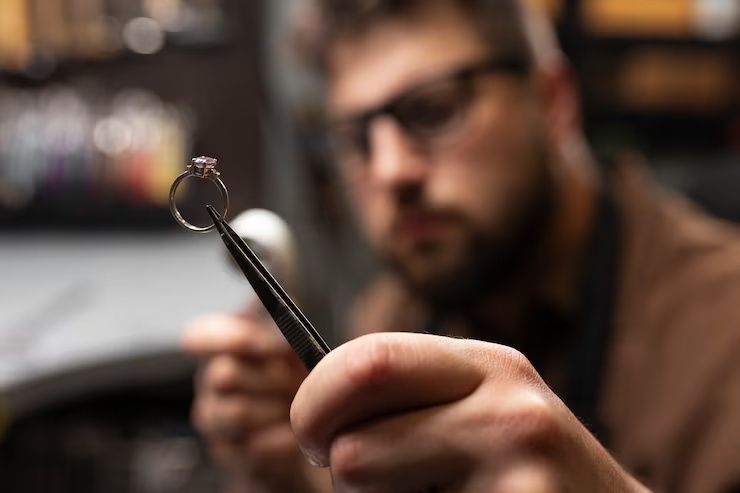Lab-grown diamonds, also known as synthetic or man-made diamonds, are real diamonds produced in a laboratory setting rather than mined from the earth. They are chemically, physically, and optically identical to natural diamonds. The key difference lies in their origin—lab diamonds are created using advanced technologies like High Pressure-High Temperature (HPHT) or Chemical Vapor Deposition (CVD).
The motivation behind lab diamonds comes from a desire to produce ethically sourced gems, reduce environmental damage caused by mining, and provide a cost-effective alternative to natural diamonds.

Why Lab-Grown Diamonds Matter Today
Lab diamonds have become increasingly relevant in recent years due to:
-
Ethical Sourcing: Unlike natural diamonds, lab diamonds are free from the concerns of conflict mining.
-
Affordability: Lab diamonds can cost up to 30–40% less than mined diamonds of comparable quality.
-
Environmental Benefits: Manufacturing lab diamonds uses less land and creates fewer ecological disturbances.
-
Quality Control: The controlled environment allows consistent quality, reducing the risks of defects.
Consumers, jewelers, and environmentally conscious buyers now often consider lab diamonds a viable alternative.
Recent Trends and Updates (2024–2025)
The lab-grown diamond industry has seen rapid growth and innovations in the past year:
-
Increased Market Share: According to a 2024 report by Bain & Company, lab-grown diamonds accounted for over 10% of the global diamond jewelry market.
-
Luxury Brands Adoption: Brands like Pandora and De Beers' Lightbox have expanded their lab diamond lines.
-
Improved Technology: CVD machines have improved, producing purer Type IIa diamonds that are indistinguishable from natural diamonds even by experts.
-
Carbon-Neutral Certification: Some companies have introduced lab diamonds certified as carbon-neutral by third-party auditors.
-
Resale Market: Platforms like Ada Diamonds and Clean Origin now offer trade-in or resale options for lab-grown stones.
This shift reflects growing acceptance and demand, especially among younger consumers.
Legal Standards and Certification Policies
Lab diamonds are regulated and certified similarly to natural diamonds:
-
GIA (Gemological Institute of America): Provides full certification for lab-grown diamonds, including cut, clarity, color, and carat weight.
-
IGI (International Gemological Institute): One of the leading institutions certifying lab-grown diamonds globally.
-
FTC Guidelines (USA): As of 2018 and reinforced in 2023, the Federal Trade Commission allows the term “diamond” to refer to both natural and lab-grown, provided the origin is disclosed.
-
BIS (India): Mandates hallmarking and labeling clarity in diamond retail and exports.
-
EU Jewelry Directives: Require transparency in labeling and ethical disclosures for all gemstones, including lab diamonds.
These certifications ensure consumer confidence and transparency in the diamond trade.
Helpful Tools and Resources for Understanding Lab Diamonds
Product Comparison & Selection
-
Brilliant Earth: Side-by-side comparison of lab vs. natural diamonds.
-
Clean Origin & James Allen: Online filters to customize lab diamond shape, cut, and clarity.
Budgeting & Value Tools
-
RapNet Price List: Monitors real-time pricing for lab-grown and mined diamonds.
-
Rare Carat: Aggregates deals across platforms and gives lab-diamond price insights.
Education & Awareness
-
GIA.edu: Educational material on lab diamond creation methods.
-
IGI.org: Certification check and educational database.
-
YouTube (e.g., Diamond Pro, Rare Carat): Video explanations comparing lab vs. natural diamonds.
These resources help buyers and professionals make informed decisions.
Frequently Asked Questions (FAQs)
Q1. Are lab diamonds real diamonds?
Yes. Lab diamonds are chemically and physically identical to natural diamonds. The only difference is their origin.
Q2. How long does it take to make a lab diamond?
Depending on the method, it takes 2 to 6 weeks to grow a lab diamond using HPHT or CVD technology.
Q3. Do lab diamonds hold resale value?
Currently, lab diamonds have lower resale value compared to natural diamonds, though platforms are emerging for resale.
Q4. Are lab diamonds environmentally friendly?
Yes, they use less energy and cause less environmental disruption than traditional mining. Some are even carbon-neutral certified.
Q5. Can jewelers tell the difference between lab and natural diamonds?
Only with specialized equipment. To the naked eye, and even under magnification, they appear the same.
Final Thoughts
Lab-grown diamonds offer a modern, ethical, and cost-efficient alternative to mined diamonds. Their increasing popularity, growing certification standards, and expanding resale infrastructure point toward a lasting presence in the jewelry and industrial markets.
With evolving technologies and global regulations ensuring transparency, lab diamonds provide an accessible choice for both personal and commercial uses.
